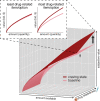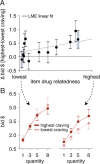A neuroeconomic signature of opioid craving: How fluctuations in craving bias drug-related and nondrug-related value
- PMID: 34916590
- PMCID: PMC9205977
- DOI: 10.1038/s41386-021-01248-3
A neuroeconomic signature of opioid craving: How fluctuations in craving bias drug-related and nondrug-related value
Abstract
How does craving bias decisions to pursue drugs over other valuable, and healthier, alternatives in addiction? To address this question, we measured the in-the-moment economic decisions of people with opioid use disorder as they experienced craving, shortly after receiving their scheduled opioid maintenance medication and ~24 h later. We found that higher cravers had higher drug-related valuation, and that moments of higher craving within-person also led to higher drug-related valuation. When experiencing increased opioid craving, participants were willing to pay more for personalized consumer items and foods more closely related to their drug use, but not for alternative "nondrug-related" but equally desirable options. This selective increase in value with craving was greater when the drug-related options were offered in higher quantities and was separable from the effects of other fluctuating psychological states like negative mood. These findings suggest that craving narrows and focuses economic motivation toward the object of craving by selectively and multiplicatively amplifying perceived value along a "drug relatedness" dimension.
© 2021. The Author(s).
Conflict of interest statement
The authors declare no competing interests.
Figures




Comment in
-
Addressing the when, what, and why of opioid craving and drug-related valuation.Neuropsychopharmacology. 2022 Jul;47(8):1429-1430. doi: 10.1038/s41386-021-01261-6. Epub 2022 Jan 9. Neuropsychopharmacology. 2022. PMID: 35001094 Free PMC article. No abstract available.
References
-
- Northrup TF, Stotts AL, Green C, Potter JS, Marino EN, Walker R, et al. Opioid withdrawal, craving, and use during and after outpatient buprenorphine stabilization and taper: a discrete survival and growth mixture model. Addict Behav. 2015;41:20–8. doi: 10.1016/j.addbeh.2014.09.021. - DOI - PMC - PubMed
-
- Konova AB, Lopez-Guzman S, Urmanche A, Ross S, Louie K, Rotrosen J, et al. Computational markers of risky decision-making for identification of temporal windows of vulnerability to opioid use in a real-world clinical setting. JAMA Psychiatry. 2020;77:368–77. doi: 10.1001/jamapsychiatry.2019.4013. - DOI - PMC - PubMed
Publication types
MeSH terms
Substances
Grants and funding
LinkOut - more resources
Full Text Sources
Medical

